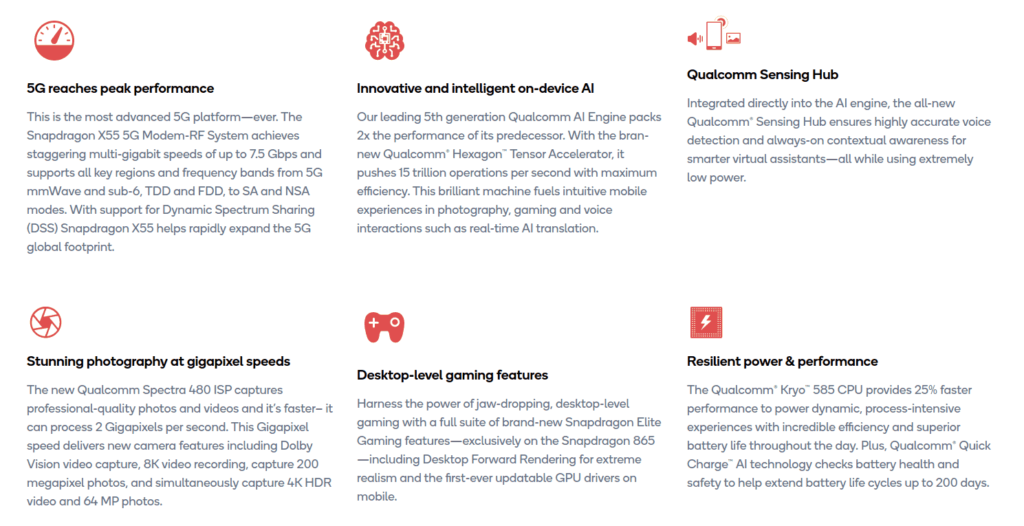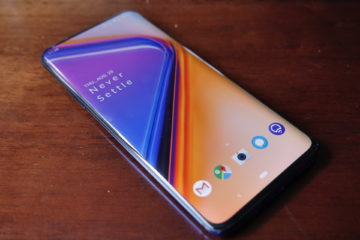Predicting the future, especially in something as fast-changing as the mobile phone industry, is notoriously hard. However two years ago I wrote this piece predicting what the mobile phones of the future might look like in 1 to 2 years time.
As it’s now been two years and 2020 is fast approaching in the next few weeks, I thought it would be a good time to review our predictions and see just how many we got correct. We’ll also look at the next generation of smartphones coming out in 2020 as well as what you can expect over the next four years.
Snapdragon™ 865 SoC Just Announced

Even though most Android manufacturers haven’t even come close to announcing their 2020 phone line up just yet, we can once again get a huge insight into what phones of that year will look like now that Qualcomm has officially launched their Snapdragon 865 Mobile Platform.
While the industry is still coming to grips with the fact that no one seems to be able to push beyond the 3 GHz barrier in phones and roughly 4 GHz barrier in desktop or laptop PC’s, almost every other metric involved in this system-on-a-chip has been improved.
The standout feature for this platform though is the incredibly wide-ranging support for all worldwide 5G networks including the extremely important millimetre-wave bandwidth. The headlining figure is a down link speed of 7.5 Gbps and up link speeds of up to 3 Gbps.
Obviously most people won’t come anywhere near getting those speeds in the real world, but even if they did the vast majority of phone storage systems aren’t even capable of writing files at that down link speed. Even the One Plus 7 Pro which only recently came out and has the latest UFS 3.0 storage I doubt would be near it. A Samsung T5 drive has a theoretical write speed of 4.3 Gbps (540 MBps) and that’s a desktop/laptop premium drive.
Besides the 5G support we have other fantastic additions such as WiFi 6, RAM support up to 16 GB with LPDDR5 memory up to 2750 MHz and a new Adreno 650 GPU which promises to be marginally faster. On top of all that we also get support for 4K screens at 60 Hz and QHD screens at 144 Hz. Video recording has also been hugely increased with support for up to 8K (woo!) at 30 frames per second and 4K at 120 frames per second.
So now that we have a really solid baseline for what the majority of Android flagships will contain next year let’s take a look at how right we were!
How Correct Were Our Predictions?

In January 2018 I wrote this piece predicting what mobile phones of the future from 2018 to 2020 might look like. In that piece I made the following rough predictions for what a phone in 2020 would possess specifications wise:
Predicted 2020 phone specs as of Jan 2018:
- Screen Resolutions: 4K UHD 120 Hz
- CPU: 3.2 GHz+
- RAM: Around 8-10 GB
- Battery: 4000-4200 mAH
- Video: 5K – Possibly Even 8K
Soon to be released Snapdragon 865 phones:
- Screen Resolutions: Likely QHD 90 Hz or higher (up to 4K @ 60 Hz, QHD+ @ 144 Hz supported on the chip)
- CPU: 2.84 GHz
- RAM: 8-12 GB (up to 16 GB supported on the chip)
- Battery: 4000-4200 mAH (quite possible we’ll see 5,000 mAh!)
- Video: 8K @ 30 FPS, 4K @ 120 FPS
As we can see, the specs are pretty damned spot on. While the screen resolutions ($K 60Hz not 120 Hz) are indeed possible via the new Snapdragon chip, it looks like the industry as a whole – and most people – seem to have settled around the QHD at 90 HZ or higher spec. While everyone loves more pixels, I expect this push back is mostly due to the fact that everyone loves longer battery life more. While a smartphone with a 4K 60 Hz screen is now technically possible and will likely get built… the battery life would be horrible for a relatively moderate bump in visual clarity. QHD at 90-144 Hz I think will be much more popular.
CPU frequency is only slightly out due to Moore’s Law finally dying while the RAM and battery specs are near spot on. Predictions of video record quality are also perfect with 8K at 30 frames per second finally coming to a phone near you soon.
This will have flow-on effects to TVs and other screens as more and more phones start recording in 8K. This is because whilst you can buy an 8K TV now, there really isn’t much point considering there’s virtually no content to watch on it except for maybe MKBHDs YouTube channel. Fast forward to the end of 2021 where millions of people are recording and uploading 8K and things start to make a lot more sense.
To The Future!

Given how accurate our predictions have been over the past two years we can look again to our handy Technology Forecaster and see what the future beyond 2020 might bring us.
While it’s quite possible that the industry might balloon out to an insane 40 GB of RAM by 2024, I think this is going to flatten out a little unless someone comes up with a legitimate and widespread use that requires lots of RAM. One thing that will be quite handy is the ever-growing capacity of batteries which should hopefully reach between 6-7,000 mAh by 2024.

If we also see solid-state batteries come into play which is looking more and more likely, this figure may even double up to 10-15,000 mAh finally giving smartphones the 2 to 4 day battery life that everyone is so desperately wanting. Who knows, with some further power tweaking you might get a week long smartphone by 2024!
Phone storage I think needs to undergo a significant advancement similar to what the computer industry went through moving from solid-state drives to NVMe. Currently 5G speeds are already maxing out the storage read and write speeds of the most advanced phones. In another 5 years that 5G or even 6G speed will be pushing 60-100 Gbps at the down link.
This is equivalent to writing around 10 GB of data every second which even the fastest NVMe PCIe Express 4.0 drives can’t handle. In the future I’d like to see the write speed increase dramatically at least to match what is common in high-end laptops and computers today.
With that read and write speed increase it’s obvious that we also need higher storage volumes and cheaper prices. While the technology forecaster predicts this could go up as high as 8-16 TB by 2024, it’s again up to what the market does and what consumers demand. With the introduction of 8K recording it’s possible that there will be a renewed demand for huge storage capacity increases but only time will tell.
Whatever the industry turns out to produce in 2024 it’s clear that phones are becoming serious pieces of technology that rival and even out pace modern-day laptops and computers. It’s entirely possible for a 2020 flagship smartphone to have better specs than most workplace desktop or laptop computers which is kind of insane when you think about it.
That being said, it does somewhat justify their also ballooning price tags. Something I’m definitely not a fan of! So are you excited for smartphones next year? What new spec bump are you most waiting on? Let us know in the comments below!
The benefits include: 1) How to get those silky smooth videos that everyone loves to watch, even if you're new 2) How to fly your drone, from taking off to the most advanced flight modes 3) Clear outlines of how to fly with step-by-step instructional demonstrations and more 4) Why flying indoors often results in new pilots crashing their drone 5) What other great 3rd party apps are out there to get the most out of your drone 6) A huge mistake many pilots make when storing their drone in the car and how to avoid it 7) How to do all of these things whilst flying safely and within your countries laws.




